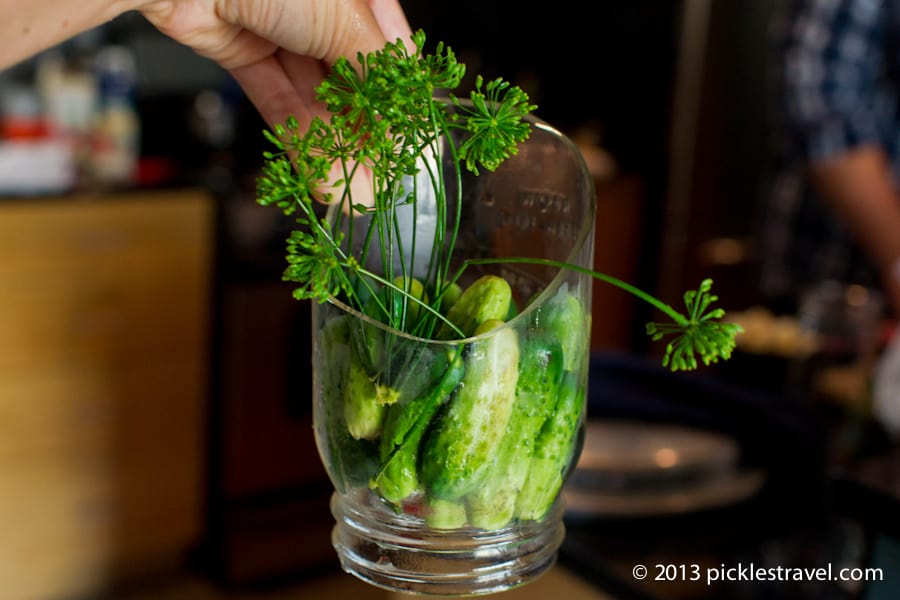It’s time for a reader question! Bay emailed to ask, “Help! My jars keep breaking when I put the wire basket in the boiling water. What am I doing wrong?”
Thanks for the question, Bay. Let me guess – pickles? It’s almost always pickles.
I’ve heard from several readers with this same jar breakage problem, and I’ve been there myself. I’ve learned a few tricks to help keep my jars crack-free, so I think I can help you out.
The quick answer is, what’s happening to cause your jars to break is called thermal shock. Basically, the glass is being asked to accommodate a too-rapid temperature change.
As your jar is lowered into boiling water, the glass attempts to expand slightly. When this expansion happens unevenly, stress builds up, and the brittle glass simply can’t take it.
Result? Cracked jars.

This awesome photo is c. 2013 Gretchen Alms. Used with permission of the photographer. Check out Gretchen’s post What Went Wrong With My Pickles? for more.
Thermal Shock 101
Imagine a hot cup of tea. Now imagine an ice cube. The tea is too hot, so you drop in the ice cube. What happens?
Pop! You can hear the ice cube cracking, right? And if you look you might see fractures form along the surface of the ice cube.
That’s thermal shock. The outside of the ice cube heats up quickly, but the inside stays cold. The uneven pressure across the ice causes the cracking.
Three things make a material more likely to experience thermal shock:
1. Flexibility vs. Brittleness
Materials like rubber respond to movement by stretching and bending. They are flexible. Materials like glass respond to movement by shattering or breaking. They are brittle.
Thermal shock in your jars is all about movement at the microscopic level – the glass is trying to expand in response to changing temperatures, but not all the glass is expanding at the same rate, and is too brittle to accommodate that movement.
2. Rate of Expansion
The more quickly a material expands or contracts in response to temperature changes, the most likely it will be to experience thermal shock.
Most glass has a fairly high rate of expansion. That’s not good news for thermal shock.
Specialty borosilicate glass has a much lower rate of expansion that makes is far less prone to thermal shock than standard soda lime glass. You are most likely to know borosilicate glass as Pyrex – up until 1998 Pyrex baking dishes and glass measuring cups were borosilicate. Then there was a buyout, a cost-cutting measure, and, well, let’s just say that if you have any pre-1998 Pyrex you should keep it forever.
3. Conductivity
When heat can pass through a material quickly and easily, that material has high conductivity. Copper has incredible heat conductivity, which is why copper is a prefered component in high-end cooking pots.
Glass has terrible conductivity. So terrible, in fact, that glass is used as an insulator – something that prevents the rapid movement of heat. Materials that are slow to conduct excess heat away are more prone to thermal shock.
Thermal Shock and Canning
Typically, jars that experience thermal shock crack at their base, all the way around the bottom. They tend to have a rather clean break that leaves the disk of the jars base separate from the rest of the jar.
→ Why? Because the thickness of the glass changes at that bottom-to-side transition zone, leading to uneven heating of the glass in this area.
Jars that have been scraped clean with a butter knife or metal spatula are more likely to crack from thermal shock.
→ Why? Because microscopic scrapes in the jar left from metal utensils can create weaknesses in the glass.
Thermal shock of jars is more common with vinegar pickles and raw packed fruit.
→ Why? Because pickles and raw fruit take a while to fit into jars, so even if the jars start pre-warmed, they’ve often cooled down by the time they get loaded into a canner. If cool jars are loaded into boiling water, they are being asked to expand rapidly, and often can’t. Result – cracked jars.
How To Stop Thermal Shock In Canning
Okay, enough background – here’s the important stuff. How do you stop your jars from cracking?
1. Inspect your jars carefully for hairline scratches or cracks
If a jar looks even a little suspect – a scratch on the inside, say, or a tiny ding on the lip of the jar – don’t process your preserve in that jar. The jar might be totally fine for dry or refrigerated storage, or for using as a drinking glass or cocktail shaker, but it’s not worth the risk to can in.
2. Heat your jars before filling
Keep your jars warm until you fill them. There’s a few ways to do this:
Clean jars should then be kept warm prior to filling. You can leave them in the closed dishwasher after the cycle, or use your canner as it is preheating, or create a separate water bath that will keep the jars both clean and warm.
Only pull out as many jars as you can fill in a timely manner. Let’s say you have some epic mega pot that can accommodate 12 quarts at a go. Well that’s only great if you can quickly fill 12 jars in a calm, methodical way. Stick with batch sizes you’re comfortable with.
3. Use piping hot brine or syrup
With jam, jelly and tomato sauce the product you are loading into the jars is often as hot as the boiling point of water anyway, so these preserves tend to help keep jars hot through the filling process.
With pickles and raw packed fruit, jars tend to cool off quickly as you arrange your produce in the jar.
Make sure any brine or syrup you pour over pickled vegetables or fruit is boiling, or at least piping hot – I’d say as hot as you can safely pour into your jars.
Remember, when brine or syrup is poured over raw cucumbers or peaches, the average temperature of the jar doesn’t come up to the temperature of the brine or syrup because the preserved vegetable or fruit absorbs some of that heat.
4. Load your jars into simmering – not boiling – water
This is the number one thing I do to avoid cracked jars – and it really works.
Instead of loading jars into water that’s at a full, rolling boil, load into water that’s at a bare simmer – say, 190 degrees. After all your jars are loaded, turn the heat up under your canning kettle and bring the water and the jars up to that boiling temp together.
Important! Start your processing time only once the water is at a full, rolling boil.
Some pickle recipes can be lower-temp pasteurized instead of being processed at a full boiling water. Here’s more info. Important! Only pasteurize pickles when an approved recipe gives this as a safe option.
5. Give your jars 5 minutes of cool down time
Typically, jars crack just as they go into the canning kettle. But, thermal shock can happen when jars cool down too rapidly or unevenly, too. It goes in both directions. A little cool-down for your jars after processing can help.
After the full processing time for your preserve has elapsed, turn off the heat under your canning kettle, and remove the lid from the kettle. Allow the jars to sit undisturbed for 5 minutes, then remove them to a draft-free area to set their seals.
This technique will help prevent cool-down thermal shock, and I also find it improves the percentage and reliability of my seals.
Do You Have A Reader Question?

Drop me a line and I might be able to answer YOUR question in a post like this.
165
BAH!!!! broken jars are the WORST! for me it’s always with green beans. nothing is worse than working that hard and having the bottom fall out of your green bean dreams. i finally got wise to the “metal utensil” thing. great info – thanks!
🙂
Thank you! It has only happened to me once (this summer!) and yes, it was pickles! I already do all of the things you suggested but the jar in question must have cooled down too long while being filled and was also an older Kerr jar and probably had a microscopic scratch just waiting for a thermal shock like that to break. I’ve since been rethinking the older jars and blue-dotting them for storage use. (I drip a big blob of blue nail polish on the bottom so I’m reminded not to can with it.)
Also, don’t set them to cool on your cold counter. Make sure to put a towel down for them to cool on.
I put my brine or syrup in one of the hot chocolate makers with the shout on it. It keeps it hot and the spout makes out easy to feel the jars.
Yep, I lost a jar to pickles this year. Thanks for the tips! Also, to anyone planning to keep their jars hot in the canner, please fill the canner with the jars already washed and in it, or at least wait to heat the water until you have placed the jars in the canner. I attempted to place my washed jars in hot canner water this year, and learned how unpredictably the water and jars acted (water spouts out, jars fall over). I ended up with a bad burn on my arm.
Mystery solved — last summer, three (three!!) of my Weck jars broke while canning. Of course, they were filled with the most labor-intensive thing ever… roasted peppers, packed in marinade. It was heartbreaking. I always suspected it had something to do with me stopping to talk on the phone for an hour mid-process… and now it is confirmed. Thanks for this great info!
Another preventive measure is to by Ball or Kerr jars and not “bargain” jars from a discount or big-box store. As cheap as I am, I discovered that the no-name jars weren’t a bargain after deducting the cost of breakage. They’re ok for jam and canned fruit but not much else.
And yeah, keep metal utensils out of them. I mostly buy wide-mouth, partly because they better accommodate a small rubber scraper.
In addition to the aforementioned excellent advice to lower jars into warm but not boiling water, I like to sterilize my jars, put them on a folded towel on a rimmed sheet and park them in a warm oven. Keeps them clean, dry, and ready to fill without thermal shock. I fill them on that same tray, and after removing them from the bath I put them back on the warm towel-lined tray and leave them overnight. Haven’t had one pop yet (although now that I just said that, it will no doubt happen, grimace.)